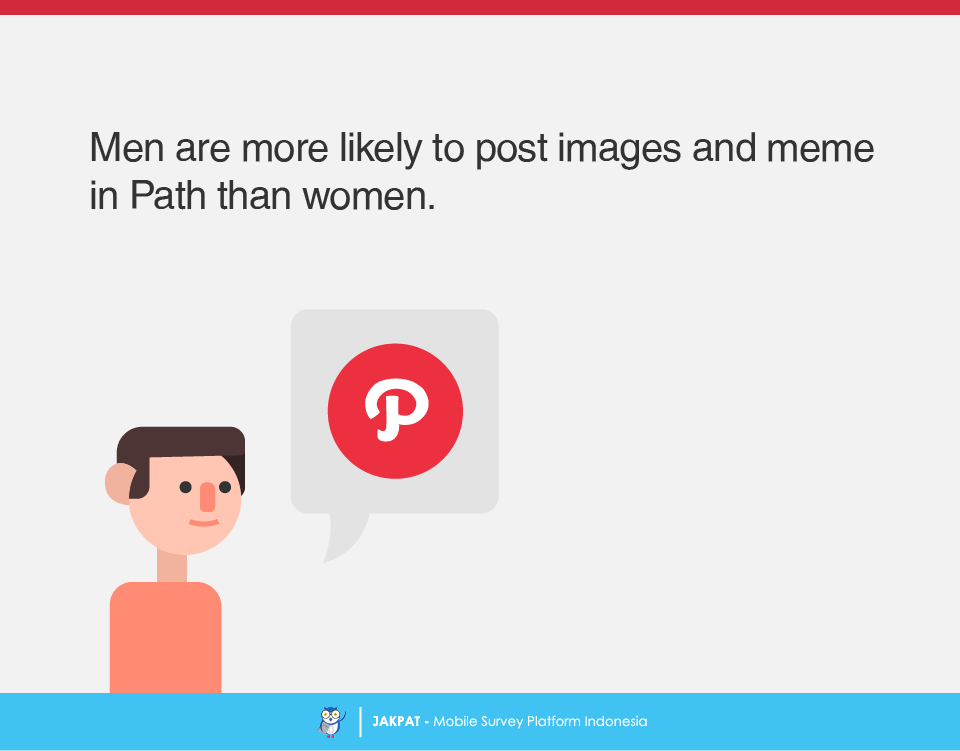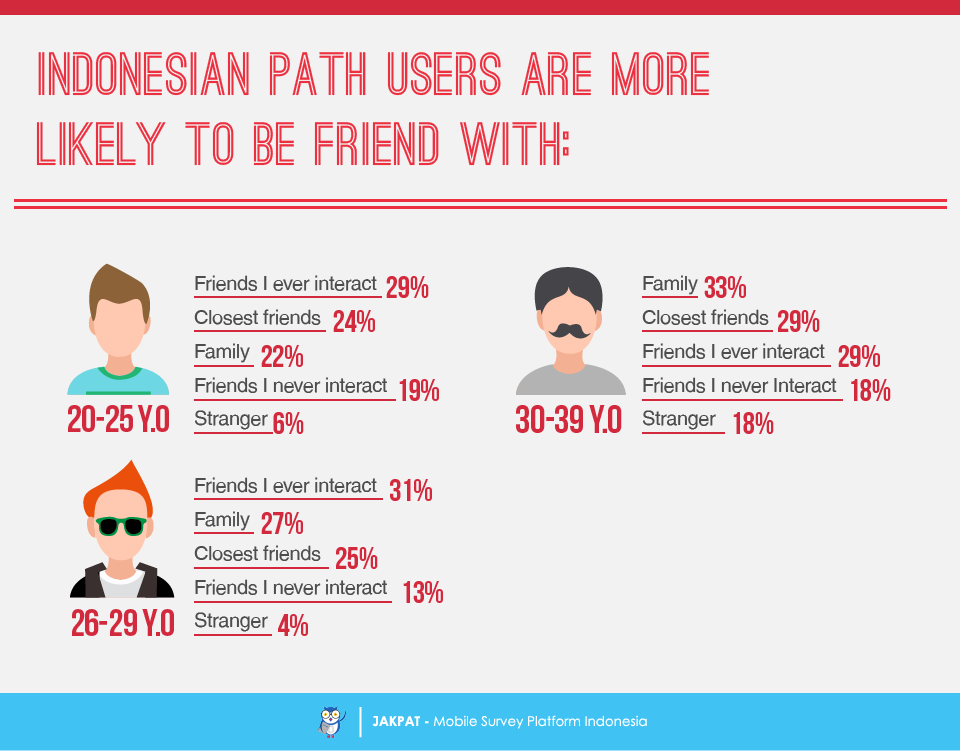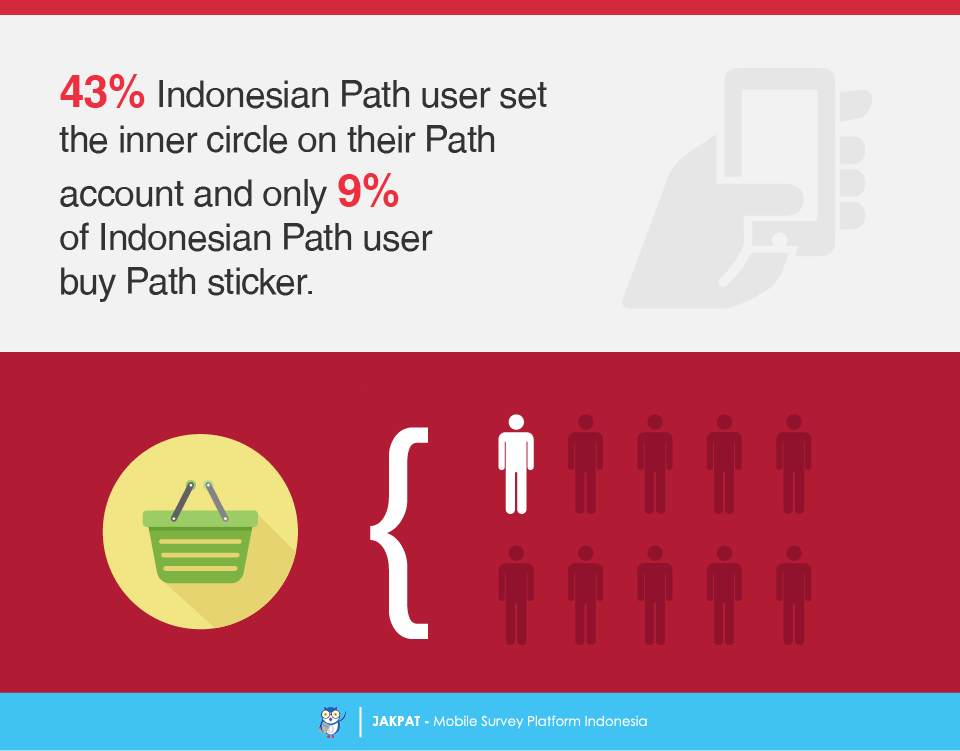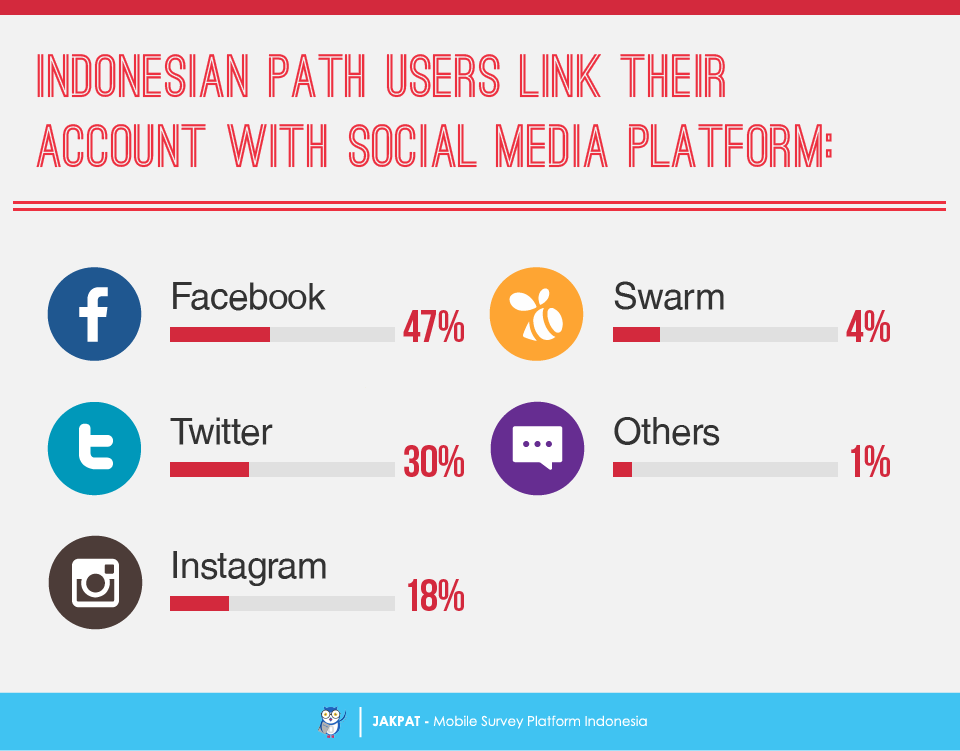Among all social media platforms, Path has been a popular platform in Indonesia for the last couple years. Just like Facebook and YouTube that were able to attract number of users, Path as well has been considered as one of the most popular application among Indonesian. Compared to other countries, Indonesia was considered as one of the biggest country of Path users. Unlike other social media platforms that tend to be more public, Path was going exclusive by providing limited number of friends to connect with. For some people, this exclusivity seems to be even more attractive as their user can select only certain person to be in their friend list. Furthermore, Path was also considered as offering more enjoyable features that was not provided by other social media platforms. Regarding to the Path popularity in Indonesia, we conducted a survey about Indonesian Path user behaviour by asking our 502 respondents in nationwide. Up to 2014, the total number of Path users in Indonesia was reaching more than 4 million. According to Krejcie and Morgan (1970) table of respondent sample, 502 respondents were considered as an acceptable number of respondents sample for the population of 4 million users. Moreover, the respondents’ proposition are balance between male and female respondents, as well as it met the 95% confidence level with 5% margin of error.
First of all, we minimize the risk of asking to the wrong respondents by selecting only respondents who install Path application in their devices. We then ask them whether they are actively access their account or just install the application without ever access it. Among all respondents who participated in the survey, 74% of them are actively access their Path account. Regarding the time of spending, most Indonesian Path users spend about 3 to 5 minutes each time they access their Path.
To expand our understanding of Path user, we asked about the frequency of accessing Path in a day. More than half of our respondents said that they access Path about 1-3 times a day. Other fewer respondents said that they access Path for 4-6 times a day (23%), 7-10 times a day (12%), and 11-15 times a day (2%). At last, 9% of respondents said that they regularly access Path up to more than 15 times a day.
As we tried to understand Indonesian Path users’ activity on accessing Path, we can summarize that they were more likely to be a passive user. They were more likely to passively responding others’ post, and posting less. 46% of respondents said that they were just reading on the timeline in most of the time. 35% respondents try to response their friends’ posting by giving emoticon, while only 3% of respondents responding others’ post by giving comments. However, only 16% of Indonesian Path users actively post content in their own account.
The quantity of posting also is investigated in this survey. We asked our respondents about the quantity of their posting in Path during a month. 76% of respondents said that they averagely share 1-10 post/month. The other 15% of respondents said that they share 11-20 post a month. Apparently, the number was slowing down as the average number of shared post increase. Only 6% of respondents said that they averagely share 21-30 post a month, as well as 3% of respondents who share 31 to more than 40 posts a month.
Funny image and meme are popular contents usually shared in any kind of social media platforms. As we found in our survey data, compared to women, men were more likely to post images and memes in Path.
Different age of respondents show different interest on shared content in Path. The 20-25 years old respondents are more likely to share their location, music they are currently listening, their photo works (scenery, food, or other things that they captured), and movie they are currently watching. The 26-29 years old respondents are more likely to share their photo works, music they are currently listening, share their location, and post their selfie/wefie picture. Different answers were also be found among the 30-35 years old respondents who are more likely to share their selfie/wefie, writing some status, their photo works, and share their location. At last, the 36-39 years old respondents are more likely to share their photo works, their selfie/wefie, sharing their location, and writing some status.
Path was once became a super private social media platform as it only offers limited number of friends to be added in their list. However, today’s Path is expanding its number of friend list so that their users can add more friends. We try to understand users’ habit of befriending by asking who people in their friend list are. The 20-25 years old respondents said that the friends they ever interacted with, closest friends, and family as the people in their list. Different answers were found among the 26-29 years old respondents who put friends they ever interacted with, family, and closest friends in the friend list. At last, the 30-39 years old respondents said that the family, closest friends and friends they ever interacted with are on the list. According to these findings, we could assume that the older the respondents’ segment, the more likely they are to prioritize their family on the friend list. In other hand, the younger the respondents, the more likely they are to be friend stranger.
One notable feature from Path was its ability to set our inner circle. Inner circle relates to the concept of which person in our friend list can see our particular post in Path. Among all the respondents participated in the survey, only 43% of them set Path inner circle. Furthermore, we also asked about paid sticker offered by Path for their regular user. As we found in our data, only 9% of Indonesian Path users buy the paid sticker.
We expand our understanding by asking respondents’ motivation on using Path. Basically, there were three reasons mentioned by respondents, although their priority of each answer was quite different. Male respondents were more likely to use Path since their friends are using the application, consider Path as a private social media platform, and it offers various features. In other hand, female respondents are using Path due to the private of Path application, it offers various features, and their friends are using Path.
Another feature offered by Path as well as other platforms are the linking feature. If we link our Path account to our other social media accounts, the content we share in Path would also be seen in our other social media accounts. Apparently, 55% Indonesian Path users were linking their account to their other social media accounts. Almost all age group of respondents were more likely to connect their Path account with other social media accounts than those who do not. However, this finding was different among the 30-35 years old respondents who were more likely to disconnect their Path with other social media accounts.
At last, we asked about which social media platforms they linked their Path account with. Apparently, Facebook and Twitter were still popular as most respondents were mentioning these two platforms. Instagram was also mentioned by 18% of respondents, while Swarm only be mentioned by 4% of them. However, there were also 1% of respondents who said that they linked their Path account with other than the previously social media subjected.
For more detail you can download XLS report at the button below (bahasa). JAKPAT report consists of 3 parts which are 1) Respondent Profile, 2) Crosstabulation for each question and 3) Raw Data. Respondent profile shows you demographic profiles ( gender,age range, location by province, and monthly spending). Cross tabulation enables you to define different demographic segment preference on each answer.
You can also download PDF here:

















Thank you! This was very helpful!